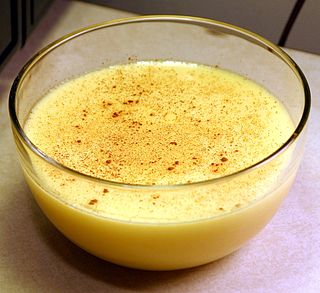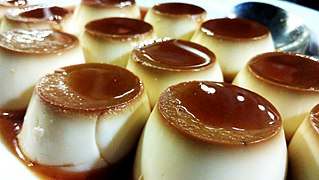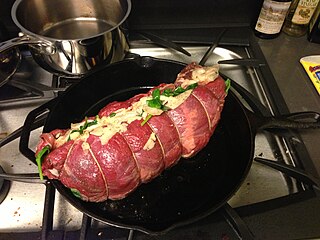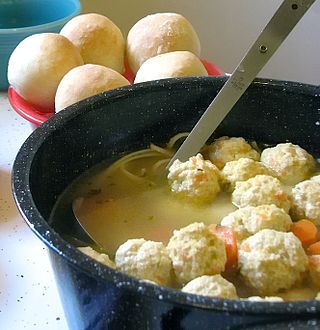This article needs additional citations for verification .(October 2016) |
A ramekin ( /ˈræmɪkɪn/ , /ˈræmkɪn/ ; also spelled ramequin) is a small dish used for culinary purposes.
This article needs additional citations for verification .(October 2016) |
A ramekin ( /ˈræmɪkɪn/ , /ˈræmkɪn/ ; also spelled ramequin) is a small dish used for culinary purposes.
The term is derived from the French ramequin, a cheese- or meat-based dish baked in a small mould. The French term is in turn derived from early modern Dutch rammeken, which translated to 'toast' or 'roasted minced meat', itself apparently from ram 'battering ram' + -kin 'diminutive', but it is unclear why. [1]
With a common capacity range of approximately 50–250 mL (1+1⁄2–8+1⁄2 US fl oz), ramekins are versatile dishes often used to bake and serve individual portions of both savory and sweet recipes. They are ideal for preparing classic dishes like crème brûlée, soufflé, molten chocolate cake, and other custard or egg-based recipes. Ramekins are also used for serving sides, condiments, or garnishes alongside entrées and can hold small portions of foods such as French onion soup, moin moin, and crumbles. Their size and heat-resistant design make them suitable for a wide range of culinary uses, from desserts to baked side dishes.
Traditionally a circular bowl with sides perpendicular to the bottom and with exterior fluting, ramekins can also be found in novelty shapes like flowers, hearts, and stars. [2]
Ramekins are usually designed to resist high temperatures, as they are frequently used in ovens or, in the case of crème brûlée, exposed to the flame of a cooking torch.

Custard is a variety of culinary preparations based on sweetened milk, cheese, or cream cooked with egg or egg yolk to thicken it, and sometimes also flour, corn starch, or gelatin. Depending on the recipe, custard may vary in consistency from a thin pouring sauce to the thick pastry cream used to fill éclairs. The most common custards are used in custard desserts or dessert sauces and typically include sugar and vanilla; however, savory custards are also found, e.g., in quiche.

Pudding is a type of food. It can be either a dessert, served after the main meal, or a savoury dish, served as part of the main meal.

Crème caramel, flan, caramel pudding, condensed milk pudding or caramel custard is a custard dessert with a layer of clear caramel sauce.

A soufflé is a baked egg dish originating in France in the early 18th century. Combined with various other ingredients, it can be served as a savoury main dish or sweetened as a dessert. The word soufflé is the past participle of the French verb souffler, which means to blow, breathe, inflate or puff.

Russian cuisine is a collection of the different dishes and cooking traditions of the Russian people as well as a list of culinary products popular in Russia, with most names being known since pre-Soviet times, coming from all kinds of social circles.

A casserole is a kind of large, deep pan or bowl used for cooking a variety of dishes in the oven; it is also a category of foods cooked in such a vessel. To distinguish the two uses, the pan can be called a "casserole dish" or "casserole pan", whereas the food is simply "a casserole". The same pan is often used both for cooking and for serving.

Au jus is a French culinary term meaning "with juice". It refers to meat dishes prepared or served together with a light broth or gravy, made from the fluids secreted by the meat as it is cooked. In French cuisine, cooking au jus is a natural way to enhance the flavour of dishes, mainly chicken, veal, and lamb. In American cuisine, the term is sometimes used to refer to a light sauce for beef recipes, which may be served with the food or placed on the side for dipping.

Kofta is a family of meatball or meatloaf dishes found in South Asian, Central Asian, Balkan, Middle Eastern, North African, and South Caucasian cuisines. In the simplest form, koftas consist of balls of minced meat—usually beef, chicken, pork, lamb or mutton, or a mixture—mixed with spices and sometimes other ingredients. The earliest known recipes are found in early Arab cookbooks and call for ground lamb.

Gratin is a culinary technique in which a dish is topped with a browned crust, often using breadcrumbs, grated cheese, egg or butter. The term may be applied to any dish made using this method. Gratin is usually prepared in a shallow dish of some kind. A gratin is baked or cooked under an overhead grill or broiler to form a golden crust on top and is often served in its baking dish.
Bosnian cuisine is the traditional cuisine of Bosnia and Herzegovina. It is influenced by Ottoman, Austro-Hungarian and Balkan cuisines.

A roulade is a dish of filled rolled meat or pastry. Roulade can be savory or sweet. Swiss roll is an example of a sweet roulade. Traditionally found in various European cuisines, the term roulade originates from the French word rouler, meaning "to roll".

Normandy tart is a shortcrust pastry-based variant of the apple tart made in Normandy filled with apples, sliced almonds and sugar, topped with creamy egg custard and baked until the topping is slightly caramelised. It is also known in French as la Tarte Normande.

A great variety of cassava-based dishes are consumed in the regions where cassava is cultivated. Manihot esculenta is a woody shrub of the spurge family, Euphorbiaceae, native to South America, from Brazil, Paraguay and parts of the Andes.

A cordon bleu or schnitzel cordon bleu is a dish of meat wrapped around cheese, then breaded and pan-fried or deep-fried.

In cooking, timbale derived from the French word for "kettledrum", also known as timballo, can refer to either a kind of pan used for baking, or the food that is cooked inside such a pan.

A meatball is ground meat (mince) rolled into a ball, sometimes along with other ingredients, such as bread crumbs, minced onion, eggs, butter, and seasoning. Meatballs are cooked by frying, baking, steaming, or braising in sauce. There are many types of meatballs using different types of meats and spices. The term is sometimes extended to meatless versions based on legumes, vegetables, mushrooms, fish or other seafood.

Crème brûlée, also known as burnt cream or Trinity cream, and virtually identical to crema catalana, is a dessert consisting of a rich custard base topped with a layer of hardened caramelized sugar. It is normally served slightly chilled; the heat from the caramelizing process tends to warm the top of the custard, while leaving the center cool. The custard base is generally flavored with vanilla in French cuisine, but can have other flavorings. It is sometimes garnished with fruit.

Nasi campur, also known as nasi rames or sego campur in Java, refers to an Indonesian and Malay dish of a scoop of nasi putih accompanied by small portions of several other dishes, which includes meats, vegetables, peanuts, eggs, and fried-shrimp krupuk.